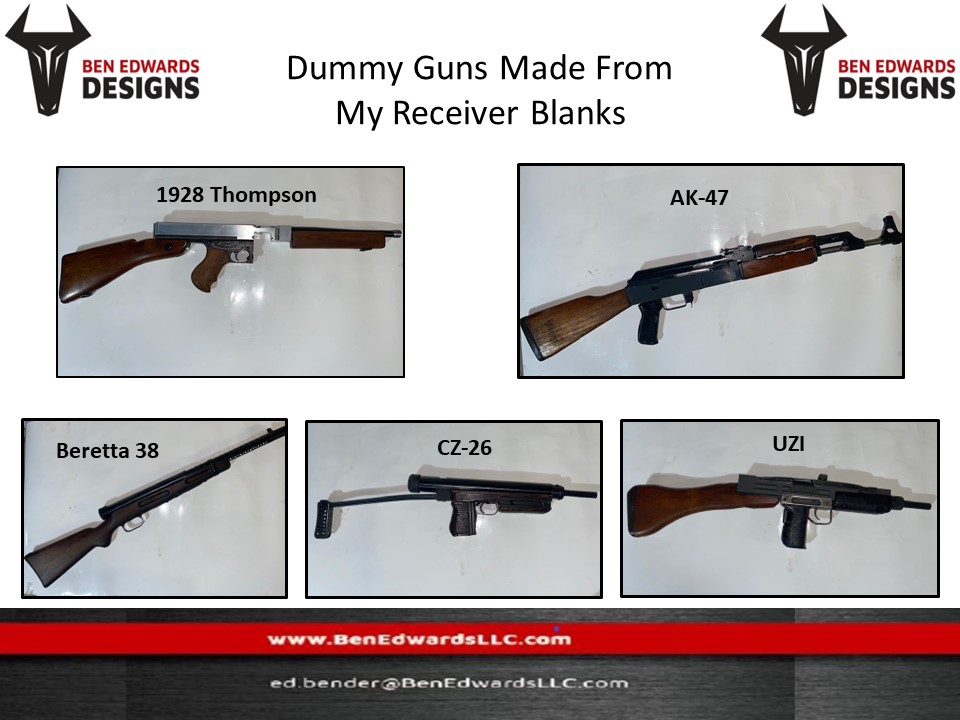Description
This display receiver is made out of 4140 and is heat treated to 43 RC. This display receiver has been modeled from original blueprints from Soviet Russia and is manufactured on a 4th axis CNC. These are compatible with the milled Bulgarian and Polish kits on the market and will accept a 23mm barrel.
NO FFL or paperwork is required.
Display receiver features are:
- Areas are present for the magazine well, trigger window, and pistol grip mount.
- Holes are present for the trigger guard rivets.
- The receiver rails are roughed out.
- ront and rear trunnions are completely machined.
Operations that would define these display receivers as a gun:
- Fully profiled bolt rails.
- Trigger pin hole.
- hammer pin hole.
- and left side of the selector hole.
- bullet guide hole.
Background
During World War II, the Sturmgewehr 44 rifle used by German forces made a deep impression on their Soviet counterparts. The select-fire rifle was chambered for a new intermediate cartridge, the 7.92×33mm Kurz, and combined the firepower of a submachine gun with the range and accuracy of a rifle. On 15 July 1943, an earlier model of the Sturmgewehr was demonstrated before the People’s Commissariat of Arms of the USSR. The Soviets were impressed with the weapon and immediately set about developing an intermediate caliber fully automatic rifle of their own, to replace the PPSh-41 submachine guns and outdated Mosin–Nagant bolt-action rifles that armed most of the Soviet Army.
The Soviets soon developed the 7.62×39mm M43 cartridge, used in the semi-automatic SKS carbine and the RPD light machine gun. Shortly after World War II, the Soviets developed the AK-47 rifle, which quickly replaced the SKS in Soviet service. Introduced in 1959, the AKM is a lighter stamped steel version and the most ubiquitous variant of the entire AK series of firearms. In the 1960s, the Soviets introduced the RPK light machine gun, an AK type weapon with a stronger receiver, a longer heavy barrel, and a bipod, that eventually replaced the RPD light machine gun.
Technical Information
| Place of origin | Soviet Union |
| Service history | |
| In service | 1949–1974 (Soviet Union) |
| 1949–present (other countries) | |
| Used by | See Users |
| Wars | See Conflicts |
| Production history | |
| Designer | Mikhail Kalashnikov |
| Designed | 1946–1948 |
| Manufacturer | Kalashnikov Concern and various others including Norinco |
| Produced | 1948–present |
| No. built | ≈ 75 million AK-47s, 100 million Kalashnikov-family weapons. |
| Variants | See Variants |
| Specifications (AK-47 with Type 3 receiver) | |
| Mass | Without magazine: |
| 3.47 kg (7.7 lb) | |
| Magazine, empty: | |
| 0.43 kg (0.95 lb) (early issue) | |
| 0.33 kg (0.73 lb) (steel) | |
| 0.25 kg (0.55 lb) (plastic) | |
| 0.17 kg (0.37 lb) (light alloy) | |
| Length | Fixed wooden stock: |
| 880 mm (35 in) | |
| 875 mm (34.4 in) folding stock extended | |
| 645 mm (25.4 in) stock folded | |
| Barrel length | Overall length: |
| 415 mm (16.3 in) | |
| Rifled bore length: | |
| 369 mm (14.5 in) | |
| Cartridge | 7.62×39mm |
| Action | Gas-operated, closed rotating bolt |
| Rate of fire | Cyclic rate of fire: |
| 600 rds/min | |
| Combat rate of fire: | |
| Semi-auto 40 rds/min | |
| Bursts 100 rds/min | |
| Muzzle velocity | 715 m/s (2,350 ft/s) |
| Effective firing range | 350 m (380 yd) |
| Feed system | 20-round, 30-round detachable box magazine |
| There are also 40-round, 75-round drum magazines available | |
| Sights | 100–800 m adjustable iron sights |
| Sight radius: | |
| 378 mm (14.9 in) | |
Service life
The AK-47 and its variants have been and are made in dozens of countries, with “quality ranging from finely engineered weapons to pieces of questionable workmanship.” As a result, the AK-47 has a service/system life of approximately 6,000, to 10,000, to 15,000 rounds. The AK-47 was designed to be a cheap, simple, easy to manufacture rifle, perfectly matching Soviet military doctrine that treats equipment and weapons as disposable items. As units are often deployed without adequate logistical support and dependent on “battlefield cannibalization” for resupply, it is actually more cost-effective to replace rather than repair weapons.
The AK-47 has small parts and springs that need to be replaced every few thousand rounds. However, “Every time it is disassembled beyond the field stripping stage, it will take some time for some parts to regain their fit, some parts may tend to shake loose and fall out when firing the weapon. Some parts of the AK-47 line are riveted together. Repairing these can be quite a hassle, since the end of the rivet has to be ground off and a new one set after the part is replaced.”









Reviews
There are no reviews yet.